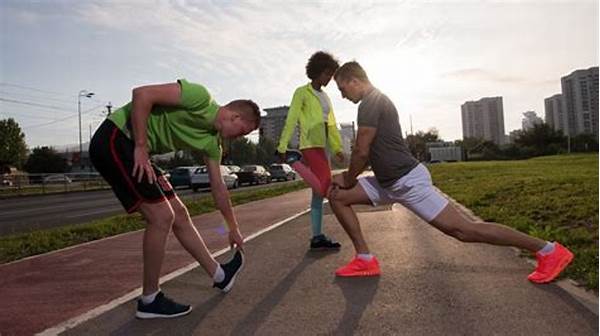Importance Of Warm-up And Cool-down In Sports

- The Science Behind Warm-Up and Cool-Down
- Introduction: Importance of Warm-Up and Cool-Down in Sports
- Unpacking the Warm-Up
- Discussions on the Importance of Warm-Up and Cool-Down in Sports
- Goals of Warm-Up and Cool-Down Routines
- Exploring the Benefits: Importance of Warm-Up and Cool-Down in Sports
- Conclusion: Key Takeaways on the Importance of Warm-Up and Cool-Down in Sports
Understanding the essence of sports doesn’t just lie in the thrill of the game or the passion for competition; it is deeply rooted in the preparation and recovery phases that surround the main event. Every athlete, whether an enthusiastic amateur or a seasoned professional, understands the necessity of incorporating comprehensive warm-up and cool-down routines into their regimen. The importance of warm-up and cool-down in sports cannot be overstated, as they play a crucial role in enhancing performance, preventing injuries, and facilitating recovery.
Read More : Health Benefits Of Running And Martial Arts
Imagine watching a thrilling sports game. The adrenaline is high, the anticipation is palpable, and everyone is focused on the athletes. However, behind the scenes, before they even step onto the field, these athletes engage in meticulous preparation to ensure their bodies are primed for performance. This preparation starts with the warm-up. Engaging in a proper warm-up session is like turning on an engine and letting it purr before hitting the gas. It gradually revs up the cardiovascular system, increases blood flow to the muscles, and raises the body temperature. All of these physiological changes help prevent sports-related injuries and improve overall performance. Additionally, a well-structured warm-up routine can enhance mental readiness, as it helps athletes focus their thoughts and calm pre-competition nerves.
As the game ends and the roaring applause fades, another crucial phase begins—the cool-down. This part of the routine is crucial for promoting recovery and helping the body return to a pre-exercise state. The cool-down assists in reducing muscle soreness and stiffness, aids in the removal of lactic acid, and helps bring the heart rate and breathing back to normal levels. This phase is often overlooked, but its significance lies in maintaining long-term athletic health. Moreover, incorporating stretching into the cool-down can promote flexibility, which is beneficial for injury prevention in the long run.
The Science Behind Warm-Up and Cool-Down
Science backs the importance of warm-up and cool-down in sports. Numerous studies indicate that athletes who consistently engage in these routines suffer fewer injuries and bounce back faster after intense activities. For instance, research by the American College of Sports Medicine highlights that an effective warm-up can improve joint range of motion, muscle elasticity, and enable faster nerve transmission, all of which are crucial for peak performance.
Warm-up and cool-down may seem mundane to outsiders, but they are the unsung heroes behind every successful sporting event. By understanding and embracing these essential practices, athletes can elevate their game, reduce the risk of injury, and ensure longevity in their sporting careers. So, the next time you lace up your trainers, remember: the first step toward greatness lies in the warm-up, and the key to sustainability is in the cool-down.
Introduction: Importance of Warm-Up and Cool-Down in Sports
In today’s fast-paced world, sports have become more than just a hobby—they are a lifestyle, a career, and for many, a passion. Within this vibrant realm, understanding the significance of each facet, from training to execution, becomes pivotal. Among these, the importance of warm-up and cool-down in sports emerges as a fundamental pillar that supports every athlete’s journey.
Warm-ups are the unsung heroes that prepare athletes for battles on the field, be it a soccer match, a marathon, or a high-pressure basketball game. They are not just about getting the heart rate up but are strategically designed to ensure that every muscle and joint is ready for action.
Conversely, cool-down sessions often take a backseat but are equally essential. They are crucial for helping the body transition back to a resting state, all while reducing the risk of muscle soreness and promoting flexibility.
Society has long recognized the importance of safety in sports, and this extends beyond wearing the right gear—it encompasses strategic preparation and recovery. As we dive deeper into this topic, we’ll explore how these practices are backed by scientific evidence and endorsed by athletic professionals worldwide.
Passionate athletes often share anecdotes about how these routines have saved them from injuries and enhanced their performance over time. From my own experience, incorporating a thorough warm-up and cool-down into my routine has not only improved my performance but has also allowed me to enjoy sports without the constant fear of injuries.
Unpacking the Warm-Up
Warm-ups are the critical prelude to any sporting activity. They gradually prepare the body for physical exertion and also help in mentally gearing up for the task at hand.
The Cool-Down Process Explained
The cool-down phase is the often-underestimated hero of an athlete’s routine. This stage is about gently bringing the body back to its natural resting state, enhancing recovery, and ensuring readiness for the next challenge.
Discussions on the Importance of Warm-Up and Cool-Down in Sports
Goals of Warm-Up and Cool-Down Routines
The primary goal of these routines is to safeguard the athlete’s body against the rigors of sporty endeavors. Prevention of injury is the most immediate concern addressed by an effective warm-up routine. By incrementally increasing the heart rate and circulation, the warm-up increases muscle temperature and flexibility, thus decreasing the risk of sprains and strains.
Read More : Benefits Of Playing Badminton
Furthermore, warm-up routines aim to enhance performance. By intensifying blood flow to muscles, and accentuating joint mobility, athletes find themselves more agile and ready to deliver peak performance when it matters most.
On the other end of the spectrum lies the cool-down routine. Post-exercise, the body requires a gentle transition to its resting state. This not only helps in achieving faster recovery by flushing out waste products from the muscles but also primes the body for the next endeavor by reducing muscle fatigue.
Ultimately, the twins of warm-up and cool-down ensure a holistic approach to sports training that champions both immediate and long-term health benefits. By safeguarding the body and enhancing performance, these routines serve as the cornerstone of sports excellence.
Exploring the Benefits: Importance of Warm-Up and Cool-Down in Sports
The importance of warm-up and cool-down in sports is undeniable and multifaceted, extending far beyond mere physical preparation. These routine practices hold immense potential for every athlete’s career longevity and effectiveness.
One significant benefit of warm-ups is their contribution to injury prevention. Engaging in a warm-up session effectively increases your joint flexibility, muscle temperature, and helps lubricate connective tissues, which all significantly minimize the likelihood of injuries during sports activities. All athletes, basically, swear by it!
From an emotive perspective, warm-ups provide a kind of mental armor. The psychological shift from ordinary calmness to athletic focus is seamlessly facilitated through warm-ups. This transition not only readies the mind for competition but generates an optimal state of motivation and confidence.
Conversely, the cool-down phase is your loyal post-game comrade. It facilitates an optimal recovery process, reduces muscle soreness, and prevents blood pooling, commonly experienced after intense physical exertions. Effective cool-down results in a harmonious heart rate decline and helps prepare the body for future exertions.
The scientific backing for these practices is substantial. Studies outline warm-ups as a key factor in enhancing physical efficiency and reducing muscle stiffness. Simultaneously, consistently practiced cool-downs are known to aid in maintaining a constant level of athletic participation by minimizing recovery disruptions.
Conclusion: Key Takeaways on the Importance of Warm-Up and Cool-Down in Sports
—
This article attempts to capture the comprehensive importance of warm-up and cool-down in sports. These practices are the lifeline that supports optimal athletic performance and ensures sustained engagement in sports. So remember, your next game starts long before you step onto the field and continues even after the final whistle blows.



